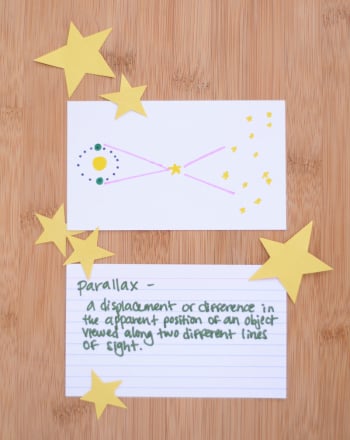Activity
Parallax
The parallax is a mathematical construct that is used to measure the distances of faraway objects like the moon and stars. It is defined as the difference between the apparent locations of an object viewed from two different perspectives. For instance, if you view a TV set from five feet to the right of it, and someone else views the same TV set from five feet to the left of it, the parallax would be the angle of perception from directly in front of the TV set. In this project you will make your own calculations using parallax principles.
Problem:
What is the parallax principle?
Materials:
- Computer with Internet access
- Color printer
- Digital camera
- Typical office/hobby/hardware/craft supplies (paper, poster board, glue, etc.).
Procedure:
- Read overview of relevant topics (see bibliography below).
- Address all of the terms and research questions mentioned here.
- Search and print out compelling images relevant to your topic.
- Construct and solve your own parallax problems.
- Carefully record all measurements and results.
- Analyze your data.
- Write a detailed report.
- Include graphics, charts and diagrams in your science fair display.
Disclaimer and Safety Precautions
Education.com provides the Science Fair Project Ideas for informational purposes only. Education.com does not make any guarantee or representation regarding the Science Fair Project Ideas and is not responsible or liable for any loss or damage, directly or indirectly, caused by your use of such information. By accessing the Science Fair Project Ideas, you waive and renounce any claims against Education.com that arise thereof. In addition, your access to Education.com's website and Science Fair Project Ideas is covered by Education.com's Privacy Policy and site Terms of Use, which include limitations on Education.com's liability.
Warning is hereby given that not all Project Ideas are appropriate for all individuals or in all circumstances. Implementation of any Science Project Idea should be undertaken only in appropriate settings and with appropriate parental or other supervision. Reading and following the safety precautions of all materials used in a project is the sole responsibility of each individual. For further information, consult your state's handbook of Science Safety.
Education.com provides the Science Fair Project Ideas for informational purposes only. Education.com does not make any guarantee or representation regarding the Science Fair Project Ideas and is not responsible or liable for any loss or damage, directly or indirectly, caused by your use of such information. By accessing the Science Fair Project Ideas, you waive and renounce any claims against Education.com that arise thereof. In addition, your access to Education.com's website and Science Fair Project Ideas is covered by Education.com's Privacy Policy and site Terms of Use, which include limitations on Education.com's liability.
Warning is hereby given that not all Project Ideas are appropriate for all individuals or in all circumstances. Implementation of any Science Project Idea should be undertaken only in appropriate settings and with appropriate parental or other supervision. Reading and following the safety precautions of all materials used in a project is the sole responsibility of each individual. For further information, consult your state's handbook of Science Safety.















